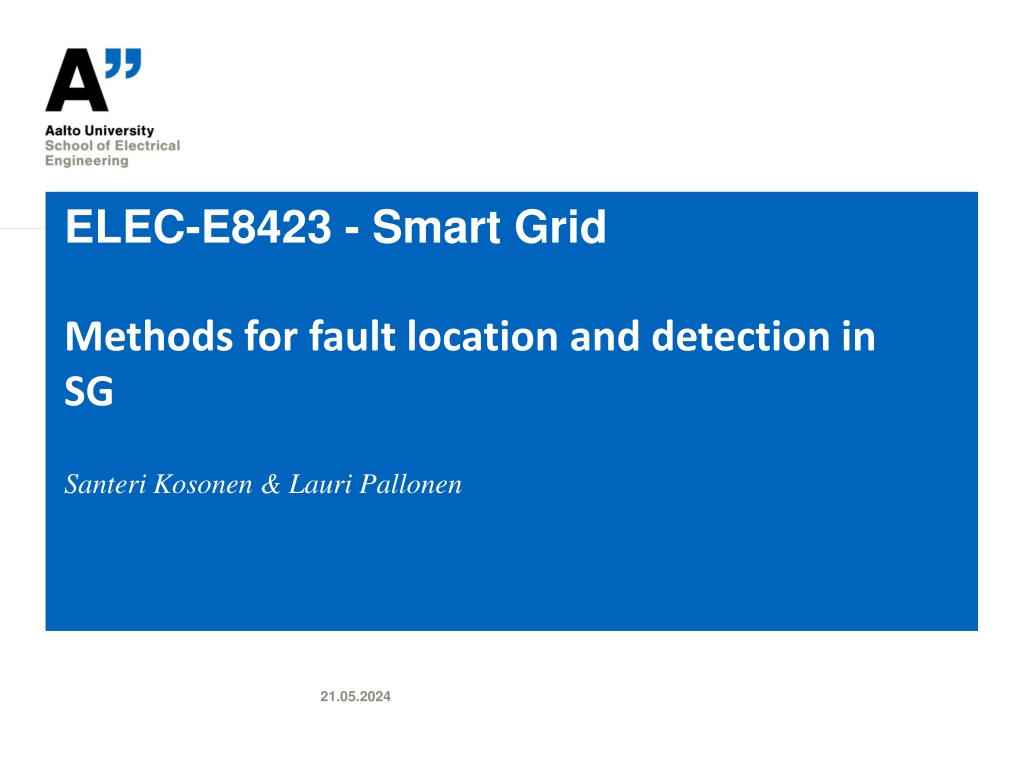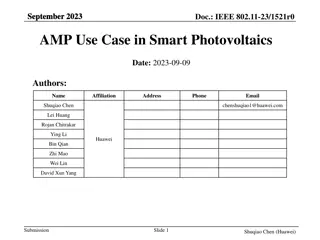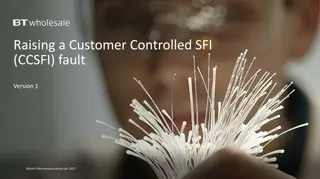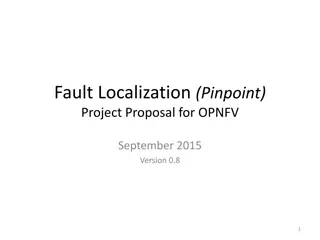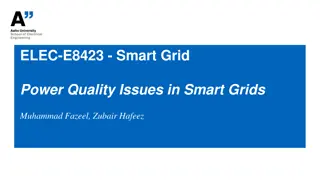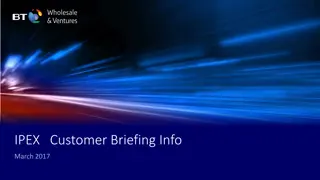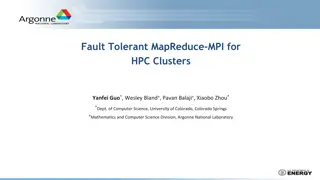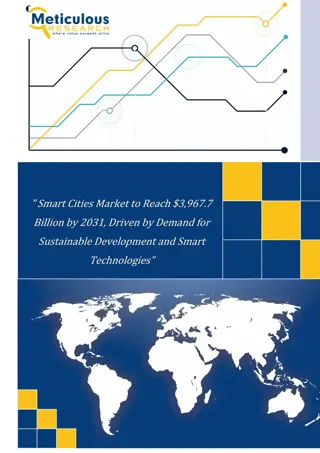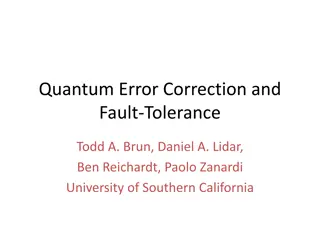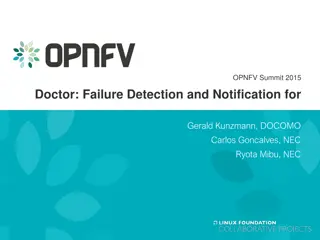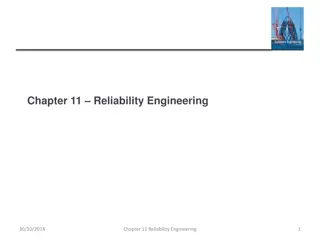Fault Location and Detection in Smart Grids
Smart Grids integrate distributed energy resources, sensing, communication, and control technologies for intelligent operation with bidirectional power flow and self-healing capability. This article explores the importance of fault location and detection in distribution networks, different types of faults, methods for measurement, and optimizing for cost efficiency. It discusses the significance of accurate fault localization, faster system restoration, reduced costs and losses, consumer satisfaction, safety impacts, and risks in power distribution systems. Various fault location methods, including centralized and decentralized approaches, impedance-based calculations, traveling wave techniques, and AI models for fault detection are also covered.
Uploaded on Mar 10, 2025 | 0 Views
Download Presentation

Please find below an Image/Link to download the presentation.
The content on the website is provided AS IS for your information and personal use only. It may not be sold, licensed, or shared on other websites without obtaining consent from the author.If you encounter any issues during the download, it is possible that the publisher has removed the file from their server.
You are allowed to download the files provided on this website for personal or commercial use, subject to the condition that they are used lawfully. All files are the property of their respective owners.
The content on the website is provided AS IS for your information and personal use only. It may not be sold, licensed, or shared on other websites without obtaining consent from the author.
E N D
Presentation Transcript
ELEC-E8423 - Smart Grid Methods for fault location and detection in SG Santeri Kosonen & Lauri Pallonen 21.05.2024
Introduction Structure Smart Grids are electric power systems that integrate distributed energy resources, advanced sensing, communication and control technologies to enable intelligent operation with bidirectional power flows and self-healing capability. Fault location and detection are a part of the Fault Location, Isolation and Restoration (FLIR) operations aiming at resolving fault situations The question of fault detection and localization is of greater importance in distribution networks than in transmission networks. 1. The importance of fault location and detection 2. Different faults 3. Methods for measurement 4. Optimizing for cost 21.05.2024 Page 2
Importance of fault location and detection Before fault isolation and restoration attempts can begin, it the fault needs to be located Accurate determination of location and type Faster system restoration Reduced cost and losses Consumer satisfaction In Finland major power disruptions have significant impact on financial performance of DSOs The regulatory model has a factor related to the energy that is not served during the outages. Safety impacts Risks to material and personnel Fire hazards, Hazard voltage 21.05.2024 Page 3
Different faults and different network desings Solidly grounded, ungrounded, compensated neutral etc., overhead vs. underground, continuous vs intermittent. Some faults are harder to detect. Single-phase to earth in unearthed or compensated systems can have very low fault currents Severity and Occurrence: Ph-Earth vs. 3-Phase fault a: 3-Ph, b: Ph-Earth, c: Ph-Ph, d: Ph-Ph-Earth, e: Broken conductor, f: Broken conductor-Earth. Figure 1 [1], Modified from the original 21.05.2024 Page 4
Fault location methods Centralized and decentralized methods Centralized methods are done at the primary substation Impedance based Impedance calculation Fault distance from impedance Accuracy locating in unearthed or compensated network challenging due to small fault current Travelling wave technique Analyzes arrival times of electromagnetic disturbances (traveling waves) caused by faults AI method Training AI models to detect faults Advantage in networks that are complex Figure 2: Earth-fault location methods [a] 21.05.2024 Page 5
Decentralized methods Decentralized methods are done at smaller secondary substations Utilize intelligent electronic devices (IEDs) and smart meters along feeders for fault location Fault passage indicators (FPIs) Detect fault conditions and communicate with control systems for fault visualization Smart meters Monitor phase voltage imbalances to deduce fault locations ABB multi-frequency admittance (MFA) Uses current and voltage measurements at secondary substations Capable of directional indication and detecting high- resistance faults Field-tested with fault resistances up to 6.2 k Figure 3: Decentralized fault location on substations [a] 21.05.2024 Page 6
Restoration sequence SWITCH Remote Terminal Unit (RTU) Control system interface for data and control Supervisory Control And Data Acquisition (SCADA) Management system utilizing computers and networked data communications Data Management System (DMS) Manages information for analysis and retrieval Fault location, Isolation and restoration (FLIR) Figure 4: Interoperability sequence diagram [3] Communicates with DMS to initiate isolation and restoration sequences 21.05.2024 Page 7
Optimizing costs of automation Investment, operation, maintenance, and costs of meters and automatic switches Required by self-healing methods Customer interruption cost (CIC) Retrofitting expensive Number of switches optimizable by strategic placement Mixed Integer learning program (MILP) model Switch placement minimizing total cost including unreliability cost and installation/operational expenses Considers customer damage functions, failure rates, fault management and earth fault events' detection and isolation Figure 5: Switch placement and method comparison [4] 21.05.2024 Page 8
Conclusions Various faults require different methods for detection Accurate measurement data and data processing improve the network's performance and safety Considering the cost and optimal placement in measurement 21.05.2024 Page 9
References [1] John Millar, ED&M07, https://mycourses.aalto.fi/pluginfile.php/2177302/mod_folder/content/0/EDM07.pdf?forcedownload=1 [2] De La Cruz J, G mez-Luna E, Ali M, Vasquez JC, Guerrero JM. Fault Location for Grids: Literature Overview, Challenges, Solutions, and Future Trends. Energies. 2023; 16(5):2280. https://doi.org/10.3390/en16052280 Distribution Smart Siirto, O., J. Kuru, and M. Lehtonen. Fault location, isolation and restoration in a city distribution network. in 2014 Electric Power Quality and Supply Reliability Conference (PQ). 2014. IEEE. [3] [4] Siirto, O.K., et al., Optimal distribution network automation considering earth fault events. IEEE Transactions on Smart Grid, 2015. 6(2): p. 1010-1018. P. Stefanidou-Voziki, N. Sapountzoglou, B. Raison, J.L. Dominguez-Garcia, A review of fault location and classification methods in distribution grids, Electric Power Systems Research, Volume 209, 2022, 108031, https://doi.org/10.1016/j.epsr.2022.108031. Farughian, A., L. Kumpulainen, and K. Kauhaniemi, Review of methodologies for earth fault indication and location in compensated and unearthed MV distribution networks. Electric power systems research, 2018. 154: p. 373-380. 21.05.2024 Page 10
